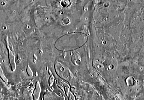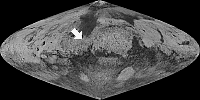![[Image of Mars Pathfinder in Mars atmosphere]](banner/marspath1a.gif)
![[Image of Mars Pathfinder Lander on Surface of Mars]](banner/marspath.gif)
Mars Pathfinder Project Information
Launch Date: 04 December 1996 UT 06:58
Arrival Date: 04 July 1997 UT 16:57
Launch Vehicle: Delta II
Mass: 264 kg (lander), 10.5 kg (rover)
Power System: Solar panels
A NASA press conference summarizing results from the Mars Pathfinder mission was
held on June 29, 1998. More details are available in the
press release
Images from Mars Pathfinder
Mars Pathfinder impacted the surface on July 4 at 16:57 UT (12:57 PM EDT) at a velocity
of about 18 m/s (40 mph) - approximately 12.5 m/s vertical and 12.5 m/s horizontal -
and bounced about 15 meters (50 feet) into the air,
bouncing another 15 times and rolling before coming to rest approximately 2.5 minutes
after impact and about 1 km from the initial impact site.
The landing site in the Ares Vallis region is at 19.33 N, 33.55 W, the lander has been
named the Carl Sagan Memorial Station.
The Mars Pathfinder's Sojourner Rover rolled onto Mars' surface on July 6
at about 05:40 UT (1:40 AM EDT).
Image received at 2:00 AM EDT July 6
shows the rover completely off the ramp, all six wheels on the martian soil.
A 9-frame movie of the Sojourner's descent down the ramp is also available (~500 K).
Mars Pathfinder status report
Preliminary Science Results
The Mars Pathfinder (formerly known as the Mars Environmental
Survey, or MESUR, Pathfinder) is the second
of NASA's low-cost planetary Discovery missions. The mission
consists of a
stationary lander
and a
surface rover.
The mission has
the primary objective of demonstrating the feasibility of low-cost
landings on and exploration of the Martian surface. This objective
will be met by tests of communications between the rover and lander,
and the lander and Earth, and tests of the imaging devices and sensors.
The scientific objectives include atmospheric entry science, long-range
and close-up surface imaging, with the general objective being to
characterize the Martian environment for further exploration. The
spacecraft entered the Martian atmosphere without going
into orbit around the planet and landed on Mars with the aid of parachutes,
rockets and airbags, taking atmospheric measurements on the way down.
Prior to landing, the spacecraft was enclosed by three triangular
solar panels (petals), which unfolded onto the ground after touchdown.
(See image above.)
The lander and rover operated until communication was lost for unknown
reasons on 27 September.
![[Image of Mars rover]](thumbnail/small_marsrover.gif)
The rover "Sojourner" is a six-wheeled vehicle which
is controlled by an Earth-based operator, who uses images
obtained by both the rover and lander systems. Note that the time
delay is about 10 minutes, requiring some autonomous control by the
rover. The primary objectives were scheduled for the first seven sols
(1 sol = 1 martian day = ~24.7 hours),
all within about 10 meters of the lander. The extended mission included
more analyses of nearby rock and soil and more tests of the rover
capabilities.
 Detailed information on the Lander and experiments
- from the NSSDCA Master Catalog
Detailed information on the Lander and experiments
- from the NSSDCA Master Catalog
 Detailed information on the Rover and experiments
- from the NSSDCA Master Catalog
Detailed information on the Rover and experiments
- from the NSSDCA Master Catalog
 Images returned by Mars Pathfinder
Images returned by Mars Pathfinder
 Information on the entry and landing strategy
Information on the entry and landing strategy
 Information on the landing site
Information on the landing site
 Mars Mileage Guide
- distance between Pathfinder and Viking landing sites and other martian features
Mars Mileage Guide
- distance between Pathfinder and Viking landing sites and other martian features
The landing site for the Mars Pathfinder is at 19.33 N, 33.55 W in the
Ares Vallis area. The site area is shown below. The first image shows the nominal
landing area as an oval superimposed on a Viking Orbiter image. The target
landing point is at the center of the oval. The second image shows the
location of the landing site (arrow) on the Mars global digital image model.


Clicking on these thumbnails gives higher resolution images.
See a
comparison of the Mars Pathfinder and Viking landing site b&w panoramas.
Shaded relief map of the landing site.
Mars global view showing the Pathfinder and Viking landing sites
Images
 Mars Pathfinder Images
Mars Pathfinder Images
 More Color Mars Pathfinder Images
More Color Mars Pathfinder Images
 More Black and White Mars Pathfinder Images
More Black and White Mars Pathfinder Images
 Historical Mars Pathfinder Images
Historical Mars Pathfinder Images
 Comparison of Mars Pathfinder and Viking B&W Panoramas
Comparison of Mars Pathfinder and Viking B&W Panoramas
 Global view of Mars showing the Mars Pathfinder and Viking landing sites
Global view of Mars showing the Mars Pathfinder and Viking landing sites
 Information on and Viking images of the landing site
Information on and Viking images of the landing site
 Information on post-landing itinerary
- for the two days after landing
Information on post-landing itinerary
- for the two days after landing
 Information on the entry and landing strategy
Information on the entry and landing strategy
 APXS analysis of the rocks and soils
APXS analysis of the rocks and soils
 APXS Mars surface composition results
- Press Release 04 December 1997
APXS Mars surface composition results
- Press Release 04 December 1997
 Mars Pathfinder mission winding down
- Press Release 04 November 1997
Mars Pathfinder mission winding down
- Press Release 04 November 1997
 Review of Mars Pathfinder activities and status
- Press Release 8 August 1997
Review of Mars Pathfinder activities and status
- Press Release 8 August 1997
 Hubble images show cloudy cold weather awaiting Mars Pathfinder
- Press Release 20 May 1997
Hubble images show cloudy cold weather awaiting Mars Pathfinder
- Press Release 20 May 1997
 Hubble detects large dust storm in Vallis Marineris
- Press Release 01 July 1997
Hubble detects large dust storm in Vallis Marineris
- Press Release 01 July 1997
 Mars Fact Sheet
Mars Fact Sheet
 Mars Home Page
Mars Home Page
 Scientific Results of the Mars Pathfinder Mission
Scientific Results of the Mars Pathfinder Mission
 Viking Orbiters and Landers to Mars
Viking Orbiters and Landers to Mars
 Mars Global Surveyor Information
Mars Global Surveyor Information
 NASA's Discovery Program
NASA's Discovery Program
 Mars Pathfinder Project Home Page
Mars Pathfinder Project Home Page
 NSSDCA Planetary Sciences Home Page
NSSDCA Planetary Sciences Home Page
 Author/Curator:
Author/Curator:
Dr. David R. Williams, dave.williams@nasa.gov
NSSDCA, Mail Code 690.1
NASA Goddard Space Flight Center
Greenbelt, MD 20771
+1-301-286-1258
NASA Official: Dave Williams, david.r.williams@nasa.gov
Last Updated: 27 June 2022, DRW
![[Image of Mars rover]](thumbnail/small_marsrover.gif)
![[Image of Mars Pathfinder in Mars atmosphere]](banner/marspath1a.gif)
![[Image of Mars Pathfinder Lander on Surface of Mars]](banner/marspath.gif)
 Detailed information on the Lander and experiments
- from the NSSDCA Master Catalog
Detailed information on the Lander and experiments
- from the NSSDCA Master Catalog Images returned by Mars Pathfinder
Images returned by Mars Pathfinder

 Mars Pathfinder Project Home Page
Mars Pathfinder Project Home Page Author/Curator:
Author/Curator: